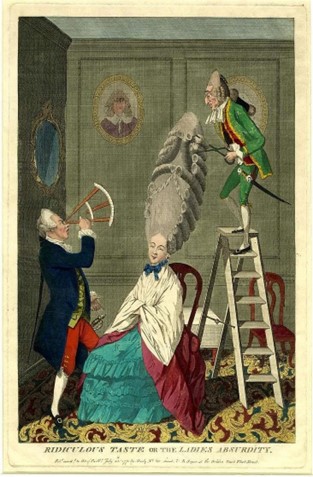‘…but in the world nothing can be said to be certain, except death and taxes…’ (Benjamin Franklin).
In Britain over the centuries this has proved to be more than evident, particularly before the nineteen hundreds, with the introduction of the Hearth Tax in 1662 to support the royal household of Charles II after the Restoration of the Monarchy, the Land Tax Act of 1692 taxing personal land and property on its annual rental value, and the Window Tax of 1778. A variety of other taxes over the years included levies on carriages (1776), servants (1777), horses (1784), hounds (1796), watches (1797) and coats of arms (1798). In addition, some were introduced which today would seem bizarre and maybe absurd.
Between 1784 and 1811 a tax was placed upon men’s hats. This was perhaps seen as a way to tax wealthy individuals who would have had any number of these. Still more unusual was the tax related to hair, and this affected even people from Southam and other local villages. As early as 1535, Henry VIII introduced a tax on beards, which at the time were seen as a symbol of the wearer’s social standing. By 1580 baldness was sweeping the country due to the prevalence of syphilis, resulting in hair loss. This made the possession of long hair desirable, and was partly why wigs became fashionable. To add to the sense of style, these varied in shape, size and colour, and ultimately denoted a sign of wealth.
In the eighteenth century, wigs became known as periwigs and, whilst they gave some protection against head lice, as they were made of animal hair they could, ironically, carry lice and cause other scalp conditions. In addition, wigs became a fire hazard due to the ubiquitous use of candles and the eccentric shapes of some wigs.
It was common to use ‘wig powder’ to enhance the appearance of the hair. This was usually made from ground starch, often with aromas such as jasmine, lavender and rose, and sometimes coloured violet, blue or pink, but mostly off-white.
Of course, the wig and powder became a new method to raise revenue by means of an annual licence for anyone using wig powder, as well as the duty paid each time the powder was purchased. The fashion and tax affected residents in Southam as well as other local parishes after 1795.
With the government desperate to raise money to fund the war with France after 1793, a duty of £1 1s (one guinea) per year was charged on the use of hair powder. The local licence was recorded at the Warwick Quarter Sessions and placed on the door of St James’s Church by the local constable.
The measure raised £210,136 in the first year, 1795. Individuals from Southam who paid the tax included: Abraham Bucknall, Sarah Cleaver, Elizabeth Cockrill, George Pearson and the Rev. John Edwards, to name but a few.
In a similar way, many years before it had been customary for men to wear their hair long, tied in ‘pig tails’ and powdered. Those who favoured this fashion were called ‘guinea pigs’, a combined neologism linking the guinea tax with the image of the pig’s tail. Another bizarre tax; but it raised money!
Southam Heritage Collection is located in the atrium of Tithe Place opposite the Library entrance. Opening times Tuesday, Thursday, Friday and Saturday mornings from 10am to 12 noon. To find out more about Southam’s history, visit our website www.southamheritage.org telephone 01926 613503 or email southamheritage@hotmail.com You can also follow us on Facebook.


Leave A Comment